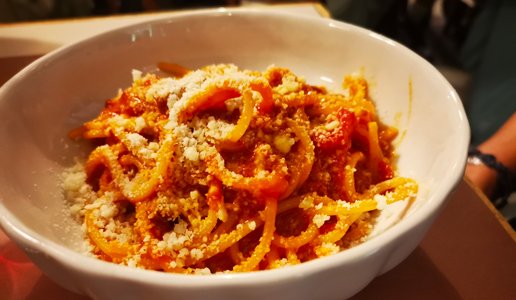A pasta dish that is considered typical of Roman cuisine but actually has Abruzzese-Latium origins, in the town of Amatrice, from which it brings two key ingredients: guanciale and pecorino cheese.
Amatrice is, but perhaps unfortunately after a terrible earthquake was, largely a medieval village. Until 1927, when Mussolini decided that Lazio, Rome’s region, should become larger, it was part of Abruzzo. It was on the border with Marche, which begins after Illica and Accumoli, a few kilometers to the east, and not far from what was then the border between the provinces of Terni and L’Aquila, then Umbria and Abruzzo.
A true Apennine melting pot, where different traditions met and where there was contact between the Abruzzese and Neapolitan traditions, because of the Kingdom of the Two Sicilies, which came fi there, and the Papal State. Before that, in the early Middle Ages, between the ecclesiastical and former Byzantine domains and the Longobard and then Frankish domains.
The “matriciani” are children of that world; some of them “emigrated” to Rome and became hosts, bringing to the Urbe their dishes, especially guanciale and pecorino, true gastronomic gems of those places. After all, pigs and sheep are the most logical and traditional herds in the culture of the Apennine people of Central Italy, where there are no vast plains for cattle.
But then in urban areas those traditions were modified. Adding tomato was not so typical in Amatrice, which is in the mountains, and also using bucatini, a pasta that probably came from Sicily perhaps because of some “wandering” cook who had arrived in Rome. But in Amatrice they talk about spaghetti, at best spaghettoni, never bucatini. And it is easier to find clear sauces and not very loaded tomato sauces.
Gricia, however, which would be matriciana in white, does not necessarily come from there. The “grici” in Rome were the charcutiers, those who had arrived in the 17th century or so from the Canton of Grisons, from Valtellina, and were called “grici” for that. To make jerky, especially, which was beloved by the Jewish community. The bresaola of the time, in short, with beef and not pork.

This is what precedes the “matriciana” (as they say in Rome), which is definitely inspired by the Amatricians but then had several admixtures as you see. Of course, compared to “carbonara,” a recent, somewhat stateless dish with no definite tradition, we are on another level here. One can possibly discuss the type of pasta (not bucatini, please), whether spaghetti, spaghettoni, even mezze maniche, which take the sauce well. But not on the guanciale, which is mandatory here, not on the pecorino di Amatrice, then we can discuss how much tomato is or is not to be used. But a tradition is there, interpretable if you will, but with some precise benchmarks.
Then my old friend Pietro Micara, a legendary Frascatan innkeeper who left us some 20 years ago, taught me a trick. The guanciale should not be cooked all over with the tomato “sinnò te se lessa,” he said. Then a little after pan-frying it, with nothing but its fat, some of which also had to be removed, he would take it out, leaving it crispy, and put it in only after he had served, giving crispiness to the dish. Something like this was said to me years later, for an entirely different recipe, by Ferran Adrià. Consistencies, temperatures, balances, are part of an evolved cuisine; they are the chiaroscuro. Pietro Micara’s “matriciana” was extraordinary, rich and elegant, and I still try to make it that way.
Curiosity:
As of March 6, 2020, Amatriciana is officially recognized as a
Traditional Speciality Guaranteed
of theEuropean Union.
In the recipe for traditional STG amatriciana, the sauce is composed of Amatrice De.Co.(municipal denomination of origin) guanciale(pork cheek ) sautéed and blended with dry white wine, San Marzano tomatoes or, alternatively, quality peeled tomatoes, Amatrice De.Co. pecorino cheese. (from the Sibillini or Laga Mountains), extra virgin olive oil, fresh or dried chili pepper, salt and pepper. As the pasta format to be seasoned for Amatrice’s traditional STG amatriciana recipe, one must strictly use that of
spaghetti
.




